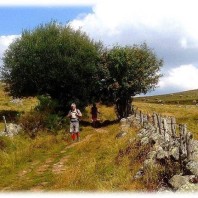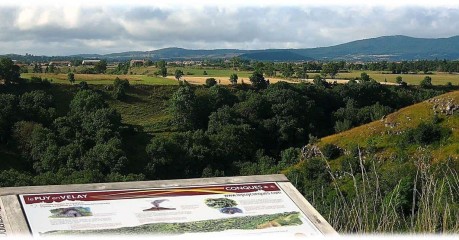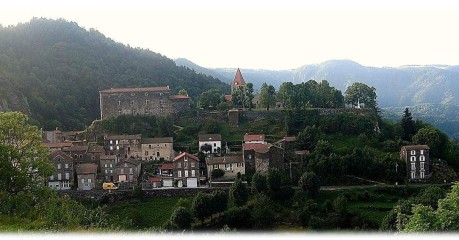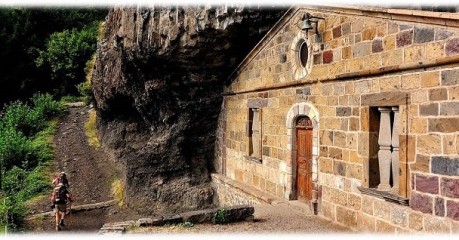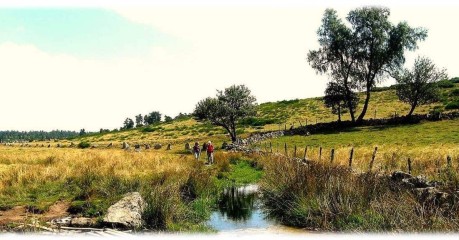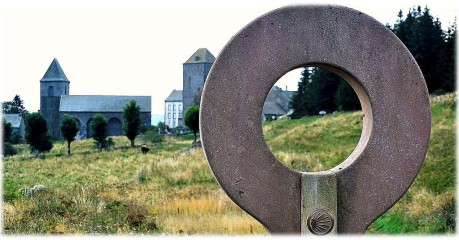Walking Via Podiensis
W
Walking Via Podiensis departs from Place du Plot in the heart of the historic centre of Le Puy. My first encounter was barely two kilometres from this fine town: a totally unplanned meeting with our Stevenson Trail donkey handlers who were promoting their tours to the passing trade – the Robert Louis Stevenson Trail also departs from near Le Puy.
Some fine scenery soon kicked in as I traversed Devès, France’s largest volcanic plateau squeezed in between the Loire and the Allier valleys. The first of the emblematic stone crosses appeared on the horizon.
Other recurrent examples of ‘patrimoin culturel’ are a plethora of fountains,’ brevoirs’ [drinking troughs],’ lavreries’ [out-door wash rooms for laundry washing] and ‘fours’ [communal bread ovens]; the omnipresent white St Jacques shells; noticeboards of all colours, shapes and sizes announcing fare, refreshment and repose along the Way; not to mention the ubiquitous chapels and churches, most of which are thankfully left open to enjoy, in direct contrast to most others found along competing long distance trails in Catholic France.
Shortly after, on a wide and stony trail near Liac, I met a middle-aged Belgian called Matthieu. He was pulling a one-wheeled luggage-transporter with poles dangling by his sides that bobbled around and toppled over on uneven surfaces – apparently his back would not support weight anymore and this contraption was the next-best thing. Why he had not considered luggage transfers, de rigeur for all our hiking trips, was beyond me; but then suffering is part of the pilgrimage tradition that we purposely avoid. This is a holiday after all!
Ramourouscle at lunchtime had been peacefully invaded by a large group of Germans doing it in style: mini-bus back-up, hot food freshly prepared roadside and the chance to ride up front if penitence became problematical. Lying nearby in a field by a Chapel was a group of four French teachers in characteristic after-lunch mode – I would have the pleasure of making their acquaintance throughout the trip as well as in my carefully-selected overnight watering hole in Saint-Privat.
Recently refurbished and boasting excellent levels of cleanliness and comfort [who needs TV?], this option allows hikers to meet each other early on and make friendships that will endure for the length of the entire hike, whichever language you speak. I wasn’t disappointed and my dining room table comprised the French ‘educators’, some long-distance pilgrims from Belgium and a single-parent from Germany.
All were understandably on a low budget, so I was delighted to ‘turn water into wine’ for the princely sum of 14 euros. Not without asking the Gallic contingent, tongue in cheek, whether they were really French, as I had never met Gallic hikers who didn’t drink wine with a meal. They took this in good spirit and retorted that I must be the Scot that confirmed the rule. The banter continued throughout and instant friendships blossomed that would be renewed from time to time over the ensuing days.
Day Two of walking Via Podiensis saw us crossing the administrative border from Auvergne into Languedoc-Roussilon, although the red and white GR waymarks remained a reassuring constant. The modest ‘Pont Eiffel’ at Monistrol d’Allier showed little of the shape of things to come, but perhaps more about what you get when given a low budget to work with. The climb out of the Gorge provides some splendid views as you climb up and past the troglodyte Chapelle de La Madeleine.
I met up again with Christiane, a ‘Political Counsellor’ from Munich. She was quiet and withdrawn today, but glad to share some of her burden with the guy who had made her feel so much at ease the previous evening. She was just one of many single women I met on the Camino, walking equidistant between the walker in front and the one behind, just in case.
Arrival at Saugues is prefaced by fine views over the surrounding countryside from the brow of the approaching hill, and there is much to enjoy culturally once you descend into the town itself, with its grandiose church and ‘tour des Anglais’ – although you might want to give the Museum of the Beast of Gevaudan a wide berth. I enjoyed a fine stay at our chambres d’hotes and an early start to the next day’s walking – a long but interesting day that we ordinarily split into two for our customers’ well-being.
Day Three of walking Via Podiensis started with the joyful sounds of a French accordion played by a lone student collecting cash to supplement his meagre grant. Sitting on a stool in the middle of nowhere, a young Korean girl listened attentively before I accompanied her to the octagonal ‘donjon,’ of Chateau La Clause. Jae had already walked from St Jean Pied du Port to Santiago de Compostella. So why return? She made so many friends along that part of The Way that she could not wait to return and walk the Via Podiensis.
Then there was Hiroshi, a young Japanese man accompanied by a Frenchman who seemed to do all of the talking, despite Hiroshi speaking near perfect English. How does a Japanese get the right to two months holiday rather than the customary two weeks? By having a father who is the boss of the firm. Hiroshi had seen the Hollywood film, The Way, and simply felt compelled to come.
The Knights’ Templar grange of Le Sauvage is a stoic sort of place where only the brave dare stay. However, the food is wholesome and served with a smile and it is the perfect place to chill out whilst you wait for your taxi to return you to Saugues for your second comfortable night with home cooking.
The walking from Le Sauvage to St Alban is most enjoyable: the St Roch shrine, the church at St Roch and the descent to St Alban. Unfortunately, St Alban itself is a rather characterless place named after ‘Albanus’, the first English Christian martyr decapitated for sheltering a fugitive priest. It is otherwise noted as a sanctuary for Lozere’s mentally ill.
St-Alban-sur-Limagnole to Aumont-Aubrac is a shortish day, but one that offers plentiful options to eat and meet en route as well as plenty of chill-out time on arrival in Aumont-Aubrac, a very pleasant market town where both our accommodation options [hotel or chambres d’hotes-led] offer a great stop-over in their own right.
The penultimate day of walking Via Podiensis sees us leave Aumont-Aubrac on a trademark sandy trail, with sweeping views across the rolling landscape. A coffee and a toilet stop beckons at Les Quatre Chemins before we are back on ‘le sentier.’ I enjoyed the climb along a narrow passageway to the massive, smooth rock outcrop known locally as Roc des Loups or Wolves’ Rock – another fictitious allusion to the ‘Beast of Gevaudan’, although the size of the rock would give cover to any marauding being, beast or otherwise.
We then descend through broom country to Riutord and walk a road that follows the course of the River Bès – a joy to behold, the river seems to meander so slowly you wonder whether the liquid has set.
A ‘tissanne’ at Montgros on the upper terrace of Rosalie’s and I was suitably refreshed and on my way for the short and delightful descent to Nasbinals. Living historically from livestock-rearing, the local peoples [Les Gabales], proved tough opposition to the progress of one Julius Caesar during the conquest of Gaul around 50BC.
Thankfully the age of tourism has softened their bellicose nature in the face of the daily invasion of bee-like hikers, who swarm around the village hives in search of knowledge, comfort and nourishment – but not necessarily in that order. Our chambres d’hotes du charme is a real peach and you can eat in the proprietor’s father’s nearby restaurant – “Pagus Gabalitanus est coniunctus!”
And so onto the Final Day of walking Via Podiensis and the Big Finish: the World Heritage Section from Nasbinals to Aubrac. In total it lasts for 9 kilometres and takes a little under three hours, but it is worth savouring: a patchwork of classic rolling and verdant countryside, decorated with copses, dry-stone walls, the odd buron [stone shelter] and, of course, the emblematic Aubrac cow.
The knee-crunching descent to St Chely was soon forgotten as I met up with the whole of the ‘St Privat table’ outside one of the welcoming bars in the main square. This time the drinks were not on me as we toasted our successful trip walking Via Podiensis!
© The Enlightened Traveller 2021 – Not to be re-produced or copied. All rights reserved.
Further Reading:
- Walking St James Way in Comfort
- Hiking Le Puy to Conques
- Camino Solo along the Camino-Frances [GR65]
![]()


Click to visit The French Hiker’s Guide to Holidaying in the Hexagon and France self-guided walking, trips, trails, places & themes.
